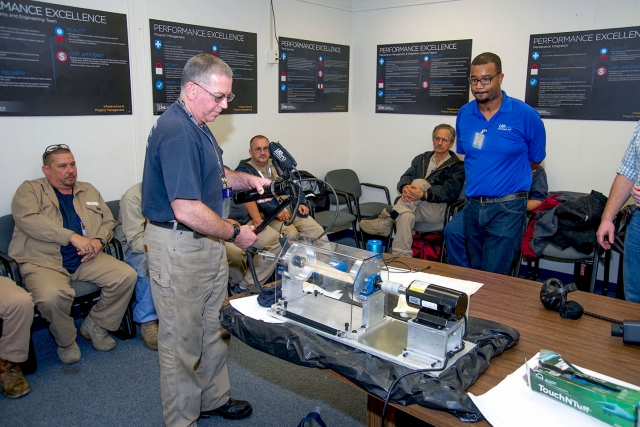
Has your air conditioning ever gone out in the middle of August? Did your dishwasher quit working when it was fully loaded from a dinner party? These types of equipment failures certainly leave us frustrated, but have you ever thought about much larger equipment failures … like the type that can delay production at a national security site for days, weeks, or months?
Enterprise Reliability and Maintainability manager Paul Durko spends a lot of time thinking about keeping Pantex and Y‑12’s equipment running so both sites can operate safely, securely, and productively. With many World War II‑era buildings and a variety of aging equipment, achieving those objectives is no small feat.
Durko’s team works with more than 530 craftspeople to complete more than 61,000 work orders each year. Just keeping up with that amount of work is a daunting task, but wanting to improve the way that work is accomplished requires a process and a special level of commitment. Fortunately, CNS has that process — preventive maintenance optimization (PMO) — and committed crafts and maintenance staff.
Maintenance strategies are evaluated through PMO, resulting in standardized tasks, which reduces maintenance errors and increases reliability. PMO has already reduced planning time by an average of 64 percent while increasing throughput by 19 percent. Durko is quick to credit the crafts as the driving force behind this success. “They are the eyes and ears of the enterprise,” he said. “Their input brings the preventive maintenance program up to date and adds value to the customer.”
Through PMO and efficiency gains, maintenance and crafts have the opportunity to implement best practices for the various maintenance tasks. “There’s a tendency to equate improved efficiency with job loss,” noted Durko. “We’re looking for efficiencies so we have the time to improve the way we provide maintenance, while also increasing the amount of preventive maintenance work completed at both sites.”
One way the crafts have driven improvement is by using ultrasound lubrication to ensure proper lubrication of bearings, which is essential to equipment reliability. This technique has been successfully piloted at both sites, and further expansion is planned.
Now ER&M wants to capitalize on those efficiency gains by using precision maintenance techniques and the resultant data to move toward condition‑based maintenance. Going back to the original, more mundane example, they want to know when to work on your air conditioner so it doesn’t go out in August.
CBM is maintenance that is performed based upon indicators from activities like surveillances, inspections, vibration monitoring, and ultrasound detection. Vibration analysis on rotating assets is the most mature predictive technology across the enterprise. In the last few years, the focus on this technology has shifted to effective use of the data provided. By analyzing this data, personnel can perform maintenance in advance of equipment failure that could injure personnel, adversely affect production, and potentially cause secondary damage to the equipment. At Y-12, the vibration program currently monitors more than 300 mission-critical assets. The program also monitors rotating assets at the Pantex High Explosives Production Facility, with revitalization and expansion planned during this fiscal year.
Predictive technology has also strengthened the effectiveness of post-work testing. Use of the vibration meter allows the craftsperson to verify that maintenance activities conducted on rotating assets did not adversely impact the reliability. The ultrasound meter has been used to improve post‑work leak checks, thus increasing the confidence in the repairs.
Durko is enthusiastic about where CBM can take the enterprise, while incorporating reliability centered maintenance‑based principles during the design phase to decrease overall maintenance cost. “Crafts and Maintenance management can evolve into a world‑class maintenance organization,” he said.